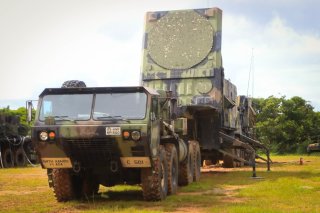The Case for More Taiwanese Missile Defense Systems
The weapons are in the process of being integrated into fixed locations around Taiwan, but the island needs more.
Should U.S. sea-launched F-35 stealth fighters be unable to achieve air superiority during a surprise Chinese air attack on Taiwan, how vulnerable would Taiwan be? On several occasions in recent years, China has flown J-10 and J-16 fighter jets over Taiwan’s Air Defense Identification Zone. Could Taiwanese air defenses stop Chinese air attacks?
Taiwan does not have large numbers of air defenses or advanced surface-to-air missiles (SAMS). Taiwan is known to operate Patriot missile defense systems and is in the process of acquiring more, according to news reports earlier this year. Yet, Patriot missile interceptors are not equipped to counter fighter jets. A Patriot can track and destroy an incoming ballistic missile to a growing extent, as well as multiple maneuvering targets at once, yet it falls well short of being able to neutralize incoming fighter jets.
Could Taiwan counter any Chinese fighter jets with SAMS? Maybe, but it may come down to a question of scale, numbers, and territorial placement. Should Taiwan have effective SAMS, would there be enough of them to counter a large Chinese air campaign? The answer is unclear. Taiwan does have domestically-engineered Sky Bow III Tien Kung Surface to Air Missile systems built by the Taiwan-based National Chung-Shan Institute of Science and Technology. The weapons can track and intercept ballistic missiles, fighter jets, and other airborne threats out to ranges of approximately 200 kilometers.
“TK III land-based air defence weapon system is composed of surface-to-air missile, canister, and mobile fire control units, including phased array radar, communication relay, engagement control station, launcher, and power plant equipment,” an Army-Technology report from 2016 explained. The Skybow, the Army-Technology report noted, is engineered with an active radar guidance system, internal midcourse guidance, and microwave seeker in the nose of the missile for accuracy.
The Skybow has “four tail fins and is vertically launched. A directional warhead with high-energy fragments enables the missile to destroy targets with high single-shot probability of kill. The missile launcher has four containers which support both TK III and TK II missiles,” the Army-Technology report added.
The weapons are in the process of being integrated into fixed locations around Taiwan.
Radio Taiwan International published a report in August 2021 saying that Taiwan is building and renovating twelve missile bases in Miaoli to house Skybow 3 systems.
These SAMS are fortified by additional air surveillance technologies and weapons interceptors, according to the military analysis journal IMINT & Analysis. In a 2021 essay, the journal said Taiwan operates eleven EW facilities, and twenty-two fixed missile batteries occupied by HAWK, Patriot, and Tien Kung SAMs.
“These systems have engagement ranges of 40 kilometers, 160 kilometers, and 200 kilometers, respectively. A further twenty two Skyguard facilities are located to provide close-in defense of key population centers and military facilities, some of which are equipped with 18 kilometer range RIM-7M Sparrow missiles,” the IMINT & Analysis report said.
Kris Osborn is the defense editor for the National Interest. Osborn previously served at the Pentagon as a Highly Qualified Expert with the Office of the Assistant Secretary of the Army—Acquisition, Logistics & Technology. Osborn has also worked as an anchor and on-air military specialist at national TV networks. He has appeared as a guest military expert on Fox News, MSNBC, The Military Channel, and The History Channel. He also has a Master's Degree in Comparative Literature from Columbia University.
Image: DVIDS.

